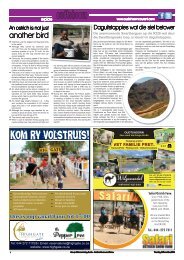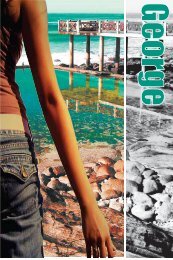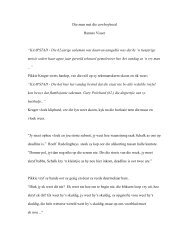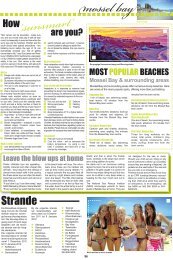See this month's feature here. - George Herald
See this month's feature here. - George Herald
See this month's feature here. - George Herald
Create successful ePaper yourself
Turn your PDF publications into a flip-book with our unique Google optimized e-Paper software.
<strong>George</strong> <strong>Herald</strong><br />
Thursday 16 May, 2013<br />
25<br />
<br />
<br />
<br />
GO101902_PM
<strong>George</strong> <strong>Herald</strong><br />
26 Donderdag 16 Mei, 2013<br />
Take care of your couch<br />
If well looked after, a lounge suite is an investment<br />
that can last for decades. Considering<br />
the cost of buying a new suite, it is<br />
worth taking special care of your furniture.<br />
Reuben Grimsell from Gommagomma<br />
recommends: “Gommagomma’s furniture<br />
which is manufactured from durable, hardwearing<br />
materials, however, certain materials<br />
and colours are easier to clean than<br />
others, so it is important to first consider<br />
your lifestyle before you buy a lounge suite.<br />
Cream upholstery, for example, is not the<br />
ideal choice for a family with small children -<br />
in <strong>this</strong> case, it is far more practical to opt for<br />
faux leather that can be wiped down with<br />
a cloth.”<br />
Grimsell provides the following 10 handy<br />
tips on how to prolong the beauty and life of<br />
your much-loved sofa:<br />
PREVENTION IS BETTER<br />
THAN CURE<br />
“Although good furniture is resilient, use<br />
common sense to keep your furniture<br />
looking good,” says Grimsell. “Don’t allow<br />
shoes, pets, sharp items or eating on your<br />
couch. If a TV dinner is part of your family<br />
life - use trays. Don’t feed a baby on your<br />
couch or let the kids do arts and crafts on it<br />
either. Remember - it takes a lot more effort<br />
to clean a sofa than to keep it clean.”<br />
DUST BUST<br />
Although it is not as visible as it is on your<br />
windowsills, for example, dust does settle<br />
onto your upholstered furniture too. “In order<br />
to extend your furniture’s life, I recommend<br />
that you vacuum or dust the upholstery<br />
every time you clean the rest of your<br />
home. The more often it gets vacuumed,<br />
the cleaner it will be and the better it will<br />
look,” adds Grimsell.<br />
THE RIGHT DETERGENTS<br />
Each material will have its own care instructions<br />
which need to be carefully followed.<br />
Says Grimsell: “Use a clean, dry cloth to immediately<br />
soak up any spillages. Note that<br />
before you use any cleaning chemicals, it<br />
is recommended that you first consult with<br />
your furniture supplier or an upholstery<br />
cleaning specialist, as using the wrong detergent<br />
could actually end up worsening an<br />
existing stain.”<br />
INVISIBLE PROTECTION<br />
For optimum upholstery, why not treat your<br />
suite with Masterguard, or one of its generic<br />
counterparts? These treatments comprise<br />
an invisible coat that can be applied to all<br />
upholstered furniture and even to curtains.<br />
It protects fabric by repelling water and<br />
stains. It lasts for approximately five washes<br />
and, t<strong>here</strong>after, it can be reapplied. “Ask<br />
your furniture store if you can get the fabric<br />
upholstery on your sofa treated before you<br />
take it home. It costs a little extra, but it will<br />
add years to your sofa’s life,” urges Grimsell.<br />
AVOID SUNSTROKE<br />
“Most creatures love baking under the African<br />
sun, but your lounge suite does not fall<br />
into <strong>this</strong> category,” warns Grimsell. “Direct<br />
sun and even bright light can cause furniture<br />
to fade. Prevent <strong>this</strong> by either rotating<br />
the various pieces of your lounge suite to<br />
minimise their exposure to the sun, or alternatively,<br />
keep them away from any window<br />
that lets in harsh sunlight.<br />
T<strong>here</strong> are many ways to arrange furniture<br />
in a room and it doesn’t need to be placed<br />
right against walls or windows. By leaving a<br />
gap between the back of a couch and wall,<br />
you create a walkway and, with the furniture<br />
closer together, the room with feel cosier.<br />
Grimsell says that if the layout of the room<br />
does not allow you much flexibility to move<br />
furniture around, you can close the curtains<br />
during the day when you are not at home.<br />
He notes that Venetian blinds or louvre<br />
shutters are also very useful options as<br />
they can be angled so that they let some<br />
light into your home’s interiors, while simultaneously<br />
minimising the amount of direct<br />
sunlight that streams in.<br />
NOT A JUNGLE GYM<br />
Your lounge suite is a treasured investment<br />
and it should be treated as such, says<br />
Grimsell: “Do not let your children jump on<br />
the couch as if it is a jungle gym and don’t<br />
let anybody sit on the arms of furniture - it<br />
puts extra strain on the structure and upholstery<br />
of the seating and it will eventually<br />
lead to your sofa losing its shape.”<br />
UPHOLSTERY THAT LASTS<br />
For maximum durability, choose strong,<br />
long-lasting upholstery for your lounge<br />
suite. “Generally speaking, woven patterns<br />
hold up longer than printed ones, as do<br />
higher thread counts. Thread count refers<br />
to the number of threads per square metre<br />
of fabric - the denser the fabric, the longer<br />
it lasts. To ensure maximum durability,<br />
even in high-traffic areas, Gommagomma<br />
uses polyester chenille and microfibers<br />
for upholstered items, which look and feel<br />
luxurious, while still remaining exceptionally<br />
hardwearing.<br />
Keep the shape of cushions and seating<br />
looking good by reshaping it to its original<br />
form from time to time - you can do <strong>this</strong> by<br />
using your hands to push microfibers into<br />
place,” explains Grimsell.<br />
WONDERFUL WOOD<br />
If your furniture has wooden detailing, it is<br />
essential that you keep it looking rich and<br />
inviting. Be careful when you clean <strong>this</strong>,<br />
as rough cleaning can stain the suite’s upholstery.<br />
To negate <strong>this</strong> issue, Gommagomma’s<br />
show-wood surfaces have all been<br />
specially treated for maximum longevity<br />
and simply need to be dusted or wiped with<br />
a clean, damp cloth.<br />
“T<strong>here</strong> is no need to use wood polish or<br />
sprays to keep Gommagomma’s wooden<br />
finishes looking shiny and new,” states<br />
Grimsell.<br />
FANTASTICALLY FAUX<br />
If you are really set on investing in a leather<br />
lounge suite, but it’s just not within your<br />
budget - why not choose a lounge suite<br />
upholstered in faux leather? Faux leather<br />
looks incredibly similar to real leather, it is<br />
a much more affordable option and it is an<br />
animal-friendly alternative to boot. Faux<br />
leather comes in many forms and some are<br />
better than others, explains Grimsell:<br />
“T<strong>here</strong> are two main types of faux leather<br />
- namely, PVC and any material that starts<br />
with ‘poly’ - most notably polyurethane and<br />
polyamide microfibre. Gommagomma, for<br />
example, uses PVC (poly vinyl chloride)<br />
and PU (polyurethane) as an affordable<br />
alternative to genuine leather. It can be<br />
washed with mild soap and water. Strong<br />
detergents and perspiration cause deterioration.”<br />
If you can’t buy leather for reasons of personal<br />
ethics or your personal budget, make<br />
sure you know what type of faux leather<br />
you’re purchasing, as Grimsell warns that<br />
some options are better than others: “Generally<br />
speaking, the poly-type materials are<br />
easier to care for, more environmentally<br />
friendly and more breathable, while PVC is<br />
more difficult to clean and doesn’t breathe<br />
as well.”<br />
He says that the other benefits of faux leather<br />
include the fact that it can be produced in<br />
virtually any colour or texture, it is very durable,<br />
a high-gloss finish can be achieved and<br />
it requires very little maintenance.<br />
MOVING MATTERS<br />
“Furniture can easily get damaged when<br />
moving,” cautions Grimsell. “You can prevent<br />
<strong>this</strong> by lifting a sofa from its base, instead<br />
of carrying it by the arms. It is also<br />
advisable to wrap each furniture piece individually<br />
in a blanket or bubble wrap and to<br />
secure it so that it can’t move around in the<br />
truck. Remember not to stack heavy items<br />
against or on top of any of the seating, as<br />
the upholstery could get damaged or the<br />
cushions could lose their shape.<br />
Get professional movers to help you if you<br />
are making a big move. The initial cost may<br />
be higher, but not as high as replacing your<br />
furniture.”<br />
Visit www.gomma.co.za or phone<br />
032 439 3500 (ask for sales) to find a<br />
Gommagomma retailer closest to you.
<strong>George</strong> <strong>Herald</strong><br />
Thursday 16 May, 2013<br />
27<br />
Be inspired by Velvet Home and Living<br />
ADVERTORIAL<br />
When you visit Velvet Home<br />
and Living, to say you’ll be<br />
bowled over is an understatement!<br />
The shop - a vast display area of 2 000m² is<br />
an absolute gem, with a plethora of modern<br />
classic and country inspired furniture showcased<br />
in individual room settings.<br />
The owners, Frank and Sue Bartman and<br />
Bianca Martinovic, have 18 years experience<br />
in home furnishing and it is clear that<br />
they are passionate about what they do.<br />
They are always abuzz with new ideas.<br />
Sourcing from factories and crafter’s around<br />
the globe, they look for new and unique<br />
pieces. It’s obvious they have a clear sense<br />
and understanding of their discerning clientele<br />
and deliver a product of in<strong>here</strong>nt value<br />
and beauty, says Martinovic.<br />
With an eye for fine detail and functionality,<br />
they feel comfort is essential to satisfaction<br />
and ensure every piece they commission is<br />
practical, stylish and above all comfortable.<br />
The look and feel is pared down luxury at its<br />
best. You will be enthralled with the selection<br />
of timeless and inviting furniture, from<br />
“kick your feet up” slipcover sofas in soft<br />
natural linens to all-weather outdoor furniture.<br />
If you are looking for stylish dining tables<br />
and chairs, the selection is gorgeous. From<br />
reclaimed Chinese elm wood to oak, ash<br />
and teak.<br />
“We know that furniture has to remain practical<br />
and robust enough to withstand everyday<br />
living, so I always keep <strong>this</strong> in mind on<br />
my fabulous buying trips,” says Martinovic.<br />
“We love re-claimed wood and the beauty<br />
of <strong>this</strong> is that you don’t have to be over particular,<br />
any blemish you may add will only<br />
enhance the in<strong>here</strong>nt beauty of the piece.”<br />
One visit and you are destined to become a<br />
regular. Instantly charmed and swept away<br />
by their French café music, soft lighting and<br />
a lingering subtle scent of lemon grass... it<br />
is retail therapy from heaven and an absolutely<br />
must see in <strong>George</strong>!<br />
Joubert Plaza 2, at the corner of Market<br />
The team from Velvet Home and Living front from left: Barrines, Georgina, Jules, Bianca,<br />
Sue, Annelize and Simone. Back Row: Sam, Gerome, Vusumzi, Frank, Fernando, Erick and<br />
Siyabonga.<br />
and Meade Streets, is the host of <strong>this</strong> hidden gem who have been trading for the past<br />
seven years.<br />
The Velvet team can be contacted on 044 873 0385 or e-mail Bianca at bianca@velvethomeandliving.com.<br />
About to build?<br />
Thermal<br />
Roof Insulation:<br />
Specify SANS<br />
approved product<br />
NB: Specify Sisalation<br />
2101<br />
Install Sisalation ® ...<br />
SA’s no. 1 foil insulation for 30 Years<br />
DID YOU KNOW . . .<br />
• <br />
insulation as a new building requirement<br />
• <br />
SISALATION IS INSULATION<br />
Not only does it reduce your carbon footprint and energy costs, it adds long<br />
term value to your home or business by<br />
• Reducing heating/cooling costs • Fire retardant safe option • Easy to install<br />
• Locally manufactured • Economical – pays for itself time and again.<br />
Don’t build without it!<br />
GO102778_PM<br />
0860 527 725<br />
www.sisalation.co.za<br />
SABS 428<br />
Part 5 & 10<br />
<br />
B/B1/2.H&V-SP&USP<br />
Distributor:<br />
INSULPACK<br />
SOUTHERN CAPE DISTRIBUTOR<br />
083 640 5403<br />
clint@insulpack.co.za<br />
GO102375_MC
<strong>George</strong> <strong>Herald</strong><br />
28 Donderdag 16 Mei, 2013<br />
Quick and easy laundry<br />
Doing the laundry can be a real drag - that<br />
is, of course, unless you have the right appliances<br />
to make it as trouble-free as possible.<br />
Liam Gawne from Miele offers some<br />
pointers on what consumers should look for<br />
when investing in a washing machine and<br />
tumble dryer.<br />
WHEN BUYING A WASHING<br />
MACHINE<br />
“When investing in a washing machine,<br />
t<strong>here</strong> are several key concepts that you<br />
need to consider - these include the amount<br />
of washing you do and the type of laundry<br />
you wash, which will affect the machine’s<br />
capacity and the wash programmes you require;<br />
how you dry your clothes, which will<br />
affect the spin speed you choose; the level<br />
of performance you require, which will be influenced<br />
by the added <strong>feature</strong>s the machine<br />
offers, as well as environment considerations<br />
and energy efficiency,” says Liam.<br />
Spin speed: The faster the washing<br />
machine’s drum spins, the more water will<br />
be extracted from the washed clothes. If<br />
you regularly use a tumble dryer to dry your<br />
laundry, then it is very worthwhile investing<br />
in a washing machine with a high spin speed<br />
as your laundry dries much quicker. Miele’s<br />
range of washing machines, for example,<br />
offers spin speeds of up to 1 600 revolutions<br />
per minute (rpm).<br />
“The dryer the clothes come out of the<br />
washing machine, the less time they will<br />
need in the tumble drier, which in turn will<br />
dramatically reduce the energy consumption<br />
required to dry the laundry.”<br />
Capacity: The bigger the washing machine’s<br />
capacity, the fewer washes you will<br />
need to do every week. It also allows you<br />
to wash big items like duvets and sleeping<br />
bags, for example. A washing machine’s<br />
capacity is measured in kilograms of dry<br />
clothes and they traditionally range from<br />
between 5kg and 10kg. Miele’s washing<br />
machines range between 6kg, which is the<br />
ideal size for a small family, and 8kg, which<br />
is recommended for larger families and big<br />
items.<br />
Energy efficiency: Washing machines<br />
are all graded in terms of how energy efficient<br />
they are on a scale from A to G, with<br />
A being the most efficient. Energy efficient<br />
washing machines use the least amount of<br />
electricity possible and they cut water consumption<br />
considerably. Although energy efficient<br />
models may cost a little more from the<br />
outset - their energy efficiency means that<br />
they pay themselves off a number of times<br />
during their life cycle.<br />
Liam says all Miele’s washing machines<br />
typically achieve consumption levels 20 per<br />
cent lower than required fro an A-rating giving<br />
them all a minimum of an A+-rating.” He<br />
notes that it is also important that a machine<br />
boasts an eco-programme for lightly soiled<br />
laundry: “Colder washes mean less electricity<br />
is used - for example a 20°C wash is 75<br />
per cent more energy efficient than that of a<br />
60°C wash.<br />
Other useful <strong>feature</strong>s include an EcoFeedback<br />
function that shows you projected<br />
consumption figures in the display so you<br />
can actually see which programmes use<br />
the least electricity and water as well as a<br />
delay start functionality, which allows you to<br />
programme the washing machine to turn on<br />
when electricity is not in high demand.<br />
Laundry care: The various wash programmes<br />
offered by a washing machine will<br />
go a long way to ensure that your laundry is<br />
well maintained. Says Liam: “Gentle laundry<br />
care tailored to the needs of specific textiles<br />
is achieved in Miele washing machines<br />
through a broad range of programmes. All<br />
you need to do is to simply select an appropriate<br />
programme from the plethora of options<br />
and leave the thinking to the machine<br />
for a perfect wash result every time.”<br />
Miele’s washing machines offer the following<br />
programmes:<br />
Cottons, minimum iron, delicates<br />
Woollens, hygiene, express 20<br />
Freshen up, automatic plus, shirts<br />
Denim, dark garments, drain/spin<br />
Steam care, sportswear, trainers<br />
Outerwear, proofing, soft toys<br />
First wash, silks, pillows, curtains<br />
Separate rinse, starch, eco, home XL<br />
Hygiene and kids, medic, nursery<br />
Beat to the drum: It is important to take<br />
a look inside a washing machine before<br />
making your purchase as the design and<br />
shape of the drum will ultimately influence<br />
the effectiveness of any machine. Liam explains:<br />
“Miele’s legendary honeycomb drum<br />
for example, continues to underline Miele’s<br />
outstanding position in the field of laundry<br />
care. Its unique sculptured pattern reduces<br />
the mechanical strain on laundry, compared<br />
with conventional drum designs, t<strong>here</strong>by ensuring<br />
the gentlest and most effective fabric<br />
care possible.”<br />
WHEN BUYING A NEW<br />
TUMBLE DRYER<br />
It is not always possible to hang your washing<br />
out to dry and <strong>this</strong> can pose a serious<br />
problem if you are a busy household or you<br />
don’t have a garden. Tumble dryers are the<br />
obvious solution - they dry your laundry,<br />
leaving it feeling soft and fluffy and they also<br />
seriously reduce the need for ironing. However,<br />
Liam explains that, as with washing<br />
machines, with tumble dryers t<strong>here</strong> are also<br />
some very important considerations that you<br />
need to think about before you make your<br />
final purchase decision - these include:<br />
Capacity: As a rule of thumb, the size<br />
of your tumble dryer should be in line with<br />
the size of your washing machine. Liam explains:<br />
“The laundry load will be removed<br />
from your washing machine and placed<br />
directly into you tumble dryer. As such, the<br />
tumble dryer will need to accommodate the<br />
same load size as your washing machine.”<br />
Energy efficiency: traditional condenser<br />
versus heat pump dryers: Tumble dryers<br />
have traditionally been known to be electricity<br />
guzzlers, but modern tumble dryers<br />
have become considerably more energy<br />
efficient over the years. The most energy efficient<br />
types of tumble dryers on the market<br />
today are heat pump condenser dryers.<br />
Liam notes the difference between the<br />
two: “Traditional condenser dryers function<br />
through the process of heating the laundry<br />
and collecting the condensation. They are<br />
relatively energy efficient, but not as efficient<br />
as heat pump dryers as they use an element<br />
to produce heat. Compared to a comparable<br />
condenser dryer, heat pump dryers can<br />
save as much as 50 per cent of energy consumed.<br />
This equates to 40 per cent more<br />
energy saved than required by an A-rated<br />
model. Heat pump dryers also function by<br />
means of condensation but use technology<br />
more similar to a refrigerator but in reverse,<br />
they recover heat energy from processed<br />
air, as well as the residual heat from the drying<br />
process, which makes them incredibly<br />
efficient.”<br />
Both types of dryers boast a container<br />
w<strong>here</strong> the water that is separated from the<br />
moist air is contained. This container can<br />
either be manually emptied after the drying<br />
cycle, or an integral pump can be installed to<br />
automatically pump it away.<br />
Take a look inside: Like the washing<br />
machine, the drum is an essential part<br />
of the drying process, says Liam: “Tumble<br />
dryers tend to have larger drums compared<br />
to washing machines, because the larger<br />
the drum, the better the efficiency of hot air<br />
flow through the machine, which ultimately<br />
results in faster drying times.<br />
Allowing fabrics to tumble freely also means<br />
less creasing and, ultimately, less ironing<br />
which is always a bonus. The best quality<br />
machines should have stainless steel<br />
drums such as Miele’s honeycomb drum for<br />
example, which boasts a smooth finish so<br />
that fabrics don’t get caught or snagged.”<br />
Something extra: Generally speaking,<br />
Liam says that the less expensive tumble<br />
dryers boast very few programmes, usually<br />
around three or four. “High-end dryers on<br />
the other hand offer the conclusion to a holistic<br />
laundry solution – finishing off what the<br />
washing machine started. As such, the better<br />
quality tumble dryers offer a range of programmes<br />
for the ultimate in laundry care.”<br />
He says that higher-end models also boast<br />
silent operation: “Sound operating models<br />
on all Miele’s tumble dryers, for example,<br />
are exceptionally low.”<br />
Miele’s tumble dryers offer the following<br />
programmes:<br />
Cottons, minimum iron, delicates<br />
Automatic plus, shirts, denim, woollens,<br />
silks<br />
Express, outerwear, sportswear,<br />
Standard pillows, large pillows<br />
Timed drying warm air, timed drying cool<br />
air<br />
Drying basket programme warm air<br />
Visit our Facebook page to view the current promotion valid from<br />
01-31 May 2013 / www.facebook.com/ontapsa.<br />
Low temperature option for cottons<br />
and minimum iron<br />
DURABILITY AND THE<br />
ENVIRONMENT<br />
It is important to consider how long your<br />
washing machine or tumble dryer will last<br />
for, as the longer it lasts, the more bang<br />
you will be getting for your buck and the<br />
lower its ultimate carbon footprint will be -<br />
meaning it is a ‘greener’ choice, explains<br />
Liam.<br />
“All Miele’s products are designed, manufactured<br />
and tested to last for a minimum<br />
of 20 years. When compared to the average<br />
7 year lifecycle of most appliances,<br />
<strong>this</strong> means that although Miele appliances<br />
might cost you a bit more initially,<br />
when you consider the fact that they will<br />
offer superlative performance for 20+<br />
years - the reality is, that they will end<br />
up saving you money in the long run. So<br />
choose a well respected brand - one that<br />
you can trust and that has earned a reputation<br />
for offering both supreme durability,<br />
as well as excellent quality and functionality.”<br />
Kloppers <strong>George</strong> situated in the Pacaltsdorp<br />
Industrial area is the only agent in<br />
the Garden Route that stock Miele products.<br />
Singing<br />
in the rain.<br />
You could go for a massage, buy a stress ball<br />
or relaxation device of some description, or you<br />
could just go home to something magnificent.<br />
We prefer the latter.
<strong>George</strong> <strong>Herald</strong><br />
Thursday 16 May, 2013<br />
29<br />
What to do in your garden in May!<br />
May is a wonderful month in the garden and<br />
as the cold winter days approach, gardens<br />
in frosty regions revel in brilliant displays of<br />
berries and the autumn foliage of deciduous<br />
trees and shrubs.<br />
In the subtropical regions colour is provided<br />
by flaming poinsettias, strelitzia, bougainvillea,<br />
red-hot pokers and tabebuia and in<br />
the winter rainfall regions the roses will be<br />
bursting into bloom.<br />
If your garden always looks dull at <strong>this</strong> time<br />
of the year, visit your local garden centre<br />
to select some late summer and autumn<br />
beauties to plant in your garden; these will<br />
be well established by next autumn and reward<br />
you with their bountiful displays.<br />
Remember that as the weather cools down<br />
germination of seeds will be slower and in<br />
very cold regions it may be prudent to buy<br />
established seedlings of slower growing<br />
varieties of winter flowers to plant out, so<br />
visit your local garden centre to select your<br />
winter favourites.<br />
Nip out the first flowers on pansy and poppy<br />
plants to encourage bushy, strong growth<br />
and feed your sweet peas every two weeks<br />
with organic 3:1:5.<br />
Tie taller growing sweet peas to a framework<br />
or trellis for support and remove any<br />
unnecessary tendrils and side shoots to<br />
ensure strong and healthy plants that will<br />
provide you with an abundance of flowers<br />
in spring.<br />
Fast maturing annuals like bokbaai vygies<br />
(Dorotheanthus), African or Namaqualand<br />
daisy (Dimorphotheca), pot marigolds (Calendula),<br />
nemesias, cornflowers and Virginian<br />
stocks can still be sown directly into<br />
garden beds.<br />
VEGGIES<br />
Sow your last crops of cabbage, Chinese<br />
cabbage, carrot, cauliflower, parsnip and<br />
Swiss chard and continue sowing and<br />
planting broad beans, broccoli, leek, let-<br />
tuce, onion, parsley, peas, turnip, celery,<br />
radish, true spinach and beet. If you have a<br />
shallow pond in full sun why not try growing<br />
some waterblommetjies (Aponogeton distachyos)<br />
for those delicious stews.<br />
They are indigenous to the winter rainfall<br />
regions and are very pretty with their long<br />
lance-shaped green leaves and scented<br />
white flowers in spring and autumn. They<br />
should be planted out now, either directly<br />
into the mud at the bottom of shallow ponds<br />
or dams, or into pots which are then submerged.<br />
(www.gardeninginsouthafrica.co.za)<br />
Bokbaaivygies<br />
Waterblommetjies (Aponogeton distachyos)<br />
Chinese cabbage<br />
In the winter rainfall and subtropical<br />
regions roses put on a<br />
beautiful show in autumn and<br />
should still be fed. If black spot<br />
is a problem, spray them with<br />
Ludwig’s Copper Count-N Fungicide<br />
and remove all diseased<br />
leaves. In very cold regions you<br />
should have stopped fertilising<br />
and your roses should be having<br />
their last flush of blooms<br />
and will start going dormant<br />
now, so reduce watering.
















